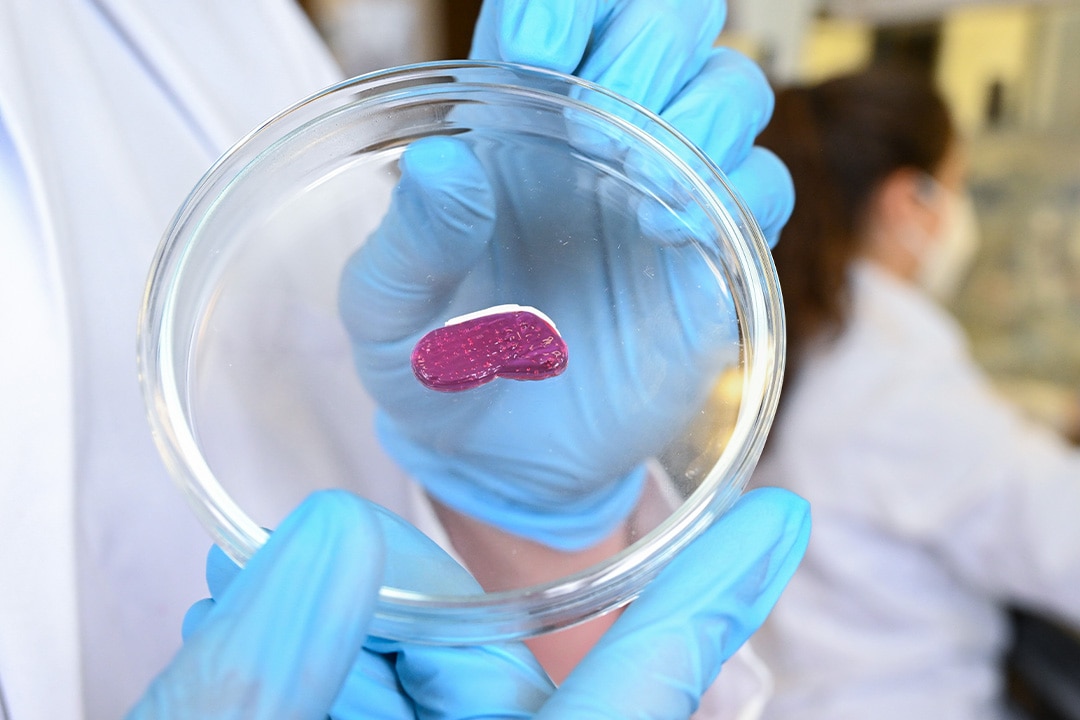Create a free profile to get unlimited access to exclusive videos, sweepstakes, and more!
Lab-Grown Meat Could End Up on Your Plate Any Day Now
Tastes like the future.

Scott Hamilton Kennedy’s 2016 documentary Food Evolution, streaming now on Peacock, explores some of the ways food scientists are working to feed an ever-increasing population. The documentary focuses largely on genetically modified foods being developed and grown all over the world.
Everything from Better Off Ted’s lab-grown cow-less beef (which tastes like despair, sadly) to Star Trek’s replicators imagines a future in which our hamburgers come without any of the associated pre-dinner violence. In 2022, the U.S. Food and Drug Administration (FDA) cleared lab-grown meat for human consumption and now two U.S companies, Eat Just and GOOD Meat, have received final approval from the U.S. Department of Agriculture to begin selling so-called cultivated meat.
Lab-Grown Meat Is Coming to Your Grocery Aisle
GOOD Meat has been selling their lab-grown chicken product in select parts of Singapore for a few years, and Eat Just already has non-lab-meat products widely available in grocery stores. Their most popular product is their plant-based liquid egg alternative Just Egg (which slaps, by the way). One or both companies are expected to deliver lab-grown meat to restaurants or grocery stores as soon as this year.
RELATED: Pork or Beef? Stem Cells Pave the Way for Lab-Grown Meat
Cultivated meat is primed to be big business as the processes are streamlined and products become available. Already, investors have dropped nearly $3 billion in funding with production plants spinning up to churn out chicken cutlets which have never seen the inside of a chicken.
Among those investments are $17 million in research grants awarded by the Good Food Institute (GFI), a non-profit focused on the production of animal product alternatives. More than half of that $17 million went to programs working toward cultivated meat.
The process of growing animal meat without the rest of the animal involves taking a biopsy of living tissue, placing those cells into culture with a nutrient bath, and getting those cells to differentiate into muscle and fat. Some processes even exercise those cells to get them to build muscle fibers similar to those in a living animal. All of that takes energy, effort, and technological know-how. Which is a whole lot harder than taking a baby cow, giving it some grass, and waiting.
The idea is to get burgers on peoples’ plates without all of the negative consequences associated with modern animal agriculture. Raising and maintaining global livestock is expensive, resource hungry, and one of the largest contributors to global greenhouse emissions. Every day there’s a little more cow burp in every breath you take. Addressing those issues while keeping everyone fed will probably require a diverse set of food innovations including GMO crops and alternative proteins. If you want a burger without eating 3D printed plant nuggets or insect-based options, lab meat might be your best and only alternative.
Of course, there are some remaining challenges. At present the cost of production remains high enough that it’s anticipated companies will initially sell products at a loss. That’s because the easiest way to grow animal flesh is inside an animal. To put a dent in the roughly 8 billion chickens consumed every year in the United States (not to mention all the cows, pigs, fish, and other animals we chow down on) we would need to build bioreactors on the scale of modern factory farming. That’s going to take a lot of investment and infrastructure before lab meat will be able to compete in the market with the real thing. But that day is coming, you better get your taste buds ready.
Catch Food Evolution, streaming now on Peacock!


























